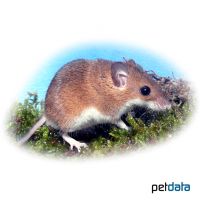African Pygmy Mouse (Mus minutoides)
| African Pygmy Mouse Mus minutoides | |
|---|---|
| Name | African Pygmy Mouse |
| Name Lat. | Mus minutoides |
| Family | Murids |
| Family lat. | Muridae |
| Order | Rodents |
| Order lat. | Rodentia |
| Origin | Africa |
| Climate | Subtropical - tropical |
| Habitat | Grassland, shrub-steppe |
| Diet | Seeds, green fodder, insects |
| Behavior | Nocturnal |
| Keeping | Pair, group |
| Care Level | Easy |
| Life Span | 1-2 years |
| Protection | No |
| Metric Units | |
| Size | 5 cm |
| Temperature | 20-24 °C |
| Housing | A: 0.3 m² / H: 50 cm |
| US Units | |
| Size | 2" |
| Temperature | 68-75 °F |
| Housing | 3 ft² / 20" hight |
Distribution and habitat
Predominantly crepuscular and nocturnal, African dwarf or peck mice, one of the smallest mammalian species, are widespread from Mozambique to South Africa. They inhabit grass and shrub steppes and are very adaptable cultural followers.
Maintenance
Minimum dimensions for the enclosure:
| 1-2 animals | area: 0.3 m² | height: 50 cm |
For each additional adult animal the area has to be increased by 20 %. A terrarium placed in a bright (no direct sunlight), draught-free and quiet place is recommended, with ventilation openings on the sides, and it must not be tightly closed at the top.
The enclosure should be structured with stones, roots and branches, and provide hiding and shelter opportunities (rodent houses, platforms, cork tubes, clay caves, hollowed coconuts, etc.). They need food and drinking containers, nesting material (hay, grass) and a substrate for digging. Commercially available small animal litter or a peat and sand mixture covered with some bark mulch and dry leaves is suitable as a substrate. The bedding depth should be 10 cm. For the wear of their teeth must always be available nail material, such as untreated twigs and branches of fruit trees, as well as a rodent stone
| temperature day: 20-24 °C | temperature night: 18-20 °C |
A natural day-night rhythm must be ensured.
Diet
They feed mainly on plants and insects. The species-specific diet consists of a mixture of dwarf hamster and gerbil food available in specialized stores, supplemented with cob millet, which also serves to keep them busy, forage hay, some fresh food (wild herbs, root vegetables) and a mineral stone. They need animal protein several times a week, such as live insects (crickets, house crickets, mealybug larvae), hard-boiled hen's egg or dry cat food. Fruit should be offered infrequently and in very small amounts. Better than a nipple waterer is a shallow clay bowl with a stone to prevent the animals from drowning. Water must always be available and, like food, should be offered fresh daily
A varied diet promotes health and prevents deficiency symptoms.
Behaviour and compatibility
They are social animals and must be cared for at least in pairs, but better in a group. They create communal nests and also raise the young together. To avoid uncontrolled reproduction, it is recommended to keep them in a same-sex group. At the first signs of incompatibility, the animals should be separated immediately.
Reproduction and breeding
Due to their small size, sex determination is difficult. In males, the distance between the anus and the urethral opening is greater than in females.
The gestation period is 18-19 days. A litter consists on average of 3-8 young, which are born naked, blind and deaf. After 12-16 days the eyes open. The young are suckled for about 18 days. They are independent after about 21 days and sexually mature at 5-6 weeks. A female may have up to 5 litters per year. The life expectancy is about 2 years.
Important
A sunny place irradiated with a heat lamp (spot) is gladly visited.
Due to their accelerated metabolism, even a short-term lack of food and water can lead to organic damage or cannibalism (offer several drinking and feeding places). The animals jump very well and far and do not like to be touched
As escape animals they need sufficient retreat and hiding places, therefore the enclosure should also be somewhat elevated and not placed on the floor. They must not be grabbed or pulled by the tail, as the skin can easily tear and detach
Lighting and heat radiators should be placed in such a way as to prevent injury to the animals. Care must be taken to ensure thorough hygiene and contamination must be removed regularly.
Further literature can be found in your pet store.
References
Text: petdata; Image: petdata
Source: BMEL (2014): Gutachten über Mindestanforderungen an die Haltung von Säugetieren; W. PUSCHMANN, D. ZSCHEILE, K. ZSCHEILE (2009): Zootierhaltung - Tiere in menschlicher Obhut: Säugetiere, Harri Deutsch Verlag; EHRLICH (2006): Kleinsäuger im Terrarium, Natur und Tierverlag
- Gemäß § 21 Abs. 5 Tierschutzgesetz idgF
